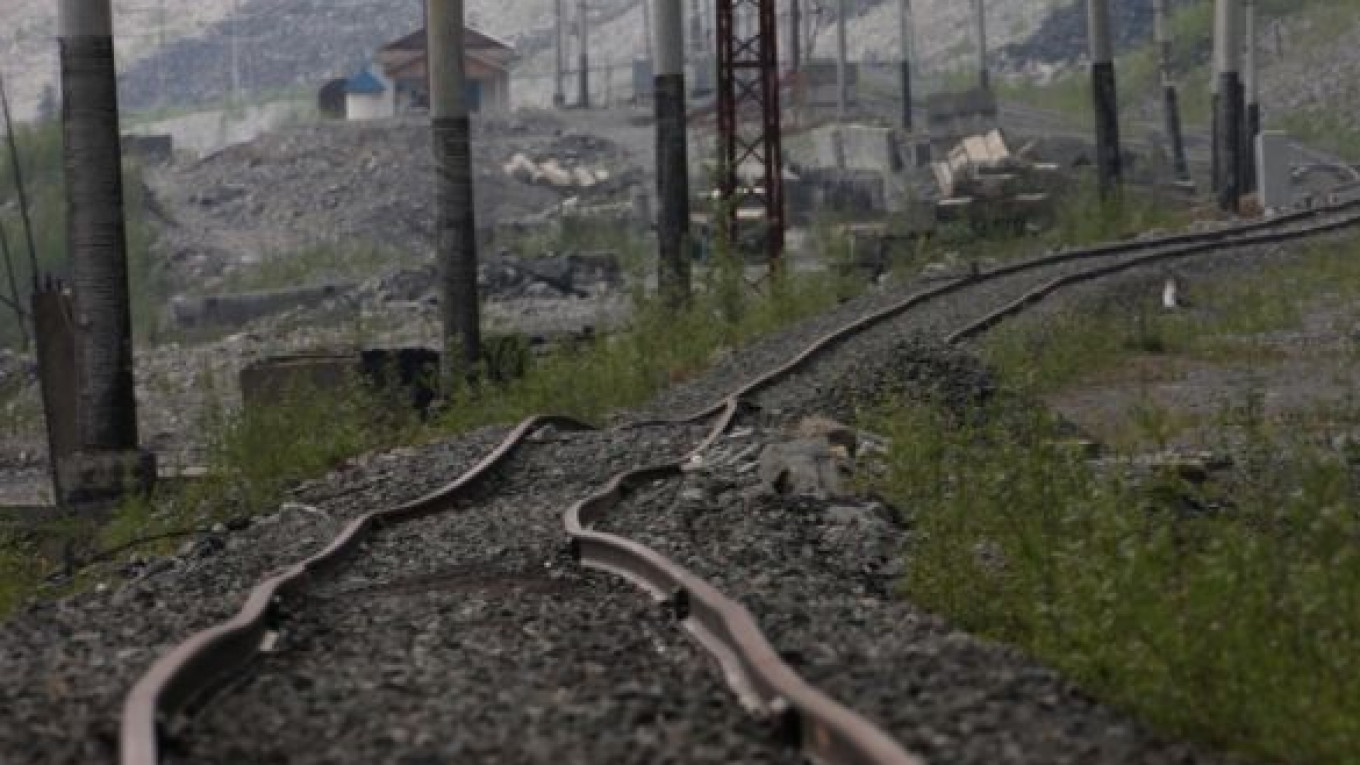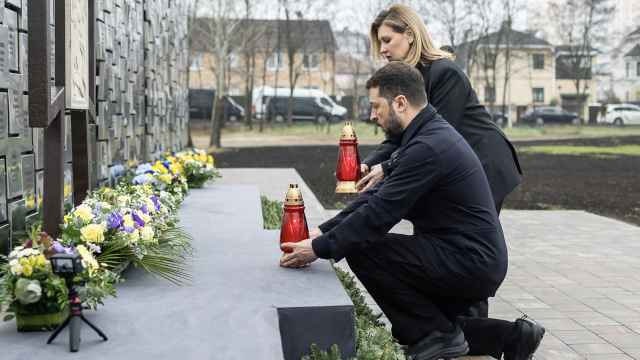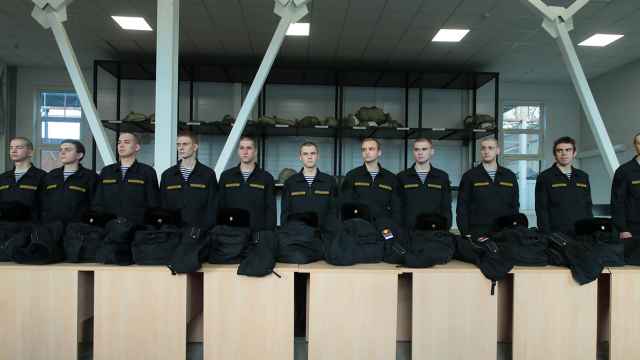Take a shovel anywhere in two-thirds of Russia's vast expanses, dig more than a meter into the ground, and you're likely to hit something rock-like.
But it isn't stone. It's permafrost — technically defined as any ground that is continuously frozen for at least two years, but in some areas it is hundreds of meters deep and tens of thousands of years old. And it is melting — putting roads, railways and buildings across the country at risk of sinking.
"In the next 25 to 30 years, the permafrost zone in Russia could shrink by 10 to 18 percent. By mid-century that could rise to 15 to 30 percent," Vladislav Bolov, head of the Emergency Situations Ministry's Center for Forecasting and Monitoring, told RIA-Novosti at the end of the summer.
The effects, he warned, would be devastating, especially on roads and railways built across the zone of permanently frozen earth.
That zone is a vast territory. Permafrost covers 10.7 million square kilometers of Russia — about 63 percent of the country.
Counting On Past Experience
Russians have been learning to live with the peculiarities of permafrost since the first explorers pushed into Siberia in the 16th century, and there is plenty of traditional knowledge and technology to draw on.
Siberian architecture has largely evolved with this experience in mind. In frozen cities like Yakutsk and Norilsk, buildings stand above the ground on piles, which are drilled through the active layer to rest on the "eternal" icy foundation below.
And water and heating pipes wind through the streets not underground, but on overhead gantries.
"It can look pretty strange to the unaccustomed eye," said Darya Smolikova, a Yakutsk native who has been living in Moscow since 2001. The buildings resemble centipedes, she said.
The legs of these "centipedes" help insulate them from the cold in winter — but more importantly, they inhibit the warmth of the structures from being conducted downward and melting the frost that acts as their foundations.
Thanks to this, Smolikova said, Yakutsk's buildings are remarkably stable, considering the harsh conditions they are built in.
In the same way, infrastructure — including roads and railways, multistory apartment buildings, oil and gas production facilities — has been built directly on the frozen ground.
But all that could change if the permanently frozen layer beneath the seasonally thawing surface begins to melt.
Russian Railways, which operates more than 5,000 kilometers of track in the permafrost zone, says it is already familiar with the problem and regularly struggles with sinking rail beds.
"The primary effect of permafrost melt is subsidence — sections of land that sink or shift unpredictably. These can appear as local subsidence tens of meters long, and as long 'wavy' areas that extend for a kilometer or more," Russian Railways said in a written statement describing the effects of melting permafrost on the landscape.
The resulting "thermokarst" landscape is characterized by rapidly appearing lakes and uneven hummocks of ground interspersed with marshland.
To make matters worse, the resultant accumulation of water lowers the upper limit of the permafrost, causing flooding. It also reduces the ground's load-bearing capacity, the company said.
And it is not just railways that are suffering. An earlier report into the impact of global warming by the Federal Meteorological Service noted that "the strength of basements of buildings and engineering constructions located on permafrost has declined in some Siberian regions" because of changes in the bearing capacity of ground induced by warming and an increase in the depth of seasonal thawing.
Not everyone is convinced that there is a problem, however.
A spokesman for road builder Rosavtodor reached by telephone struck a note of bravado when asked whether the melting was a cause for concern.
"On the contrary, we're only glad," spokesman Andrei Menshov said. "Actually, the less permafrost there is, the easier it is to build roads." He did not elaborate, and a promised interview with a Rosavtodor expert never materialized.
And Smolikova, who grew up in Yakutsk, said a lot of the rules have turned out to be bendable.
"There was a myth that because of permafrost it was impossible to lay asphalt because it would crack in winter. But then a new mayor came a long who — so they say — stole less, and the roads miraculously became much smoother," Smolikova said.
"Another myth was that you couldn't build railways in eastern Siberia, but as soon as Putin said we should produce more diamonds and precious stones, it turned out you can," she added.
"Personally, I think that if houses are collapsing in Yakutsk, it's for the same reason they do everywhere else in Russia: because of dilapidation and violations of building technology."
Bolov said the "negative effects on transport links can already be observed."
Nonetheless, Mikhail Grigoriyev, an expert at the Russian Academy of Sciences' Institute for Permafrost Studies in Yakutsk, which has been researching the phenomenon since the 1960s, is not alarmed.
"We have seen warming. In eastern Siberia, for example … it's getting warmer — in some places we've seen rises of half a degree Celsius, and in others 2 degrees — and that's serious. But we don't see catastrophic consequences," he said by telephone.
Glacial Speed Affects Perceptions
The process, however, is gradual. Russian Railways estimates that the ground temperature is rising by "as much as" 0.2 degrees Celsius per decade in the north, and 0.5 degrees in the east.
Grigoriyev cautioned that the climate models such forecasts are based on are not perfect — and the speed of warming (and the consequent degradation of permafrost) can vary from year to year.
"It's happening — but warming has slowed in the past couple of years. It's not happening now as fast as it was in 2006 or 2007, for example," he said.
Nor is the thaw uniform. It depends on altitude, moisture in the soil and a host of other factors that mean total temperature increases recorded in various locales of Siberia vary from 0.5 to 2 degrees Celsius.
Zones of Danger
Russia's vast permafrost is divided into three zones — the insular, discontinuous and continuous — depending on the durability and depth of the frozen ground.
In the "continuous" zone, which includes most of Siberia from the Yenisei River to the Bering Strait, the ground is permanently frozen to depths of hundreds of meters, and the temperature is as low as minus 10 degrees Celsius.
But the continuous zone, which has been frozen for tens of thousands of years, is bound by less durable belts of "discontinuous" and "insular" zones, where freezing may last only a few years at a time.
It is here that marginal temperature increases can have far-reaching consequences.
Temperatures in western Siberian zones, including the Yamal Peninsula, will rise 1.5 to 2 degrees, bringing it up to between minus 3 and 4 degrees, Bolov of the Emergency Situations Ministry estimated.
That is not enough to completely thaw the ground, but it does mean that the so-called "active" surface layer that thaws during summer could become deeper and thaw for longer, jeopardizing buildings whose foundations rely on the "eternal" frost below.
The biggest threats, if there are any, will occur in the peripheral "insular" belt, which extends from the Kola Peninsula and Arkhangelsk region on the European Arctic coast, sweeps to the south through parts of northern China and Mongolia and includes parts of the Kamchatka Peninsula.
According to the Emergency Situations Ministry, the southern boundary will retreat 150 and 200 kilometers to the northeast in coming decades. "Several tens of kilometers" could be lost by mid-century in the Irkutsk region, Khabarovsk territory, the Komi Peninsula and Arkhangelsk, and between 100 and 150 kilometers in Khanty-Mansiisk and the Sakha republic.
Different Scenarios, Same Problems
But that is not set in stone; the Federal Service for Hydrometeorology and Environmental Monitoring report considered no less than four potential scenarios — ranging from complete melt on the steppe by 2020 to only a partial melt by 2050.
All this makes the process difficult to predict, said Kirill Chistikov, a fellow of the Russian Geographical Society and expert on permafrost at St. Petersburg State University. And it also complicates the response.
The main danger in the frozen heart of the continuous zone that covers the vast expanses of the Sakha republic, Chukotka and Magadan is to buildings whose foundations may fracture as the depth of the summer melt increases and reduces the load-bearing capacity of the frost.
The threat to roads, railways and pipelines is much more significant in the south, where the discontinuous and insular belts are in retreat. "Islands" of permafrost exist alongside nonfrozen ground, and the constantly shifting boundaries cause some dramatic shifts in topography.
Experience Brings Solutions
Nonetheless, these are not especially new processes, Grigoriyev said.
And since the 1960s, Russian road and rail builders have stabilized ground temperatures with the use of "liquid-vapor thermo-siphons" — metal tubes filled with frozen carbon dioxide that are put in the ground along roads and rail lines, with one end in the frost below the active layer and another in the air above it. Natural heat exchange reduces temperatures by between 1 and 5 degrees Celsius.
Russian Railways favors thermo-siphons in areas of high snowfall in the north, but said it also recommends building drainage systems to remove meltwater from thermokarst lakes.
This may explain the nonchalance of companies like Russian Railways or Rosavtodor — they have, after all, been dealing with these problems for years.
The difference is that the increased pace of change will require a more proactive strategy.
A 2009 Greenpeace report into the social and economic impact of climate change in the permafrost zone, which Grigoriyev co-authored, recommends careful monitoring by city authorities of building foundations in the north so that they can either be stabilized with thermo-siphons, or at least abandoned before they collapse, and a monitoring system to give early warning of the subsidence threat to roads, railways and pipelines in the south.
But no strategy to deal with anticipated permafrost changes had been adopted at either the federal or regional level at the time that report was written, and there have been no announcements in the two years since that would indicate any improvement in the situation.
How Much Could It Cost?
"To be honest, we don't really know," said Igor Podgorny of Greenpeace. "We simply don't know how to assess such a big change so many years in the future."
Despite the Emergency Situations Ministry's warning forecasts, it is anyone's guess how much the melting could cost companies or the government.
If the authorities have attempted to estimate the economic effects of thawing, their studies have not been made public.
Neither Russian Railways nor Rosavtodor responded when asked whether they had estimated the costs associated with mitigating permafrost melt.
The Human Factor
The immediate threat is not from the long-term progress of degradation, say both Grigoriyev and Chistikov, but poor understanding of proper behavior for those who choose to live and build in the zone.
"There are a lot of rules about how you need to build. Unfortunately, we have structures that are sometimes not properly built and not properly used," he said.
"In some places waste disposal goes directly into the ground, under or near buildings, including hot water, and even worse, salty water. In those areas where the permafrost temperature is minus 1, or even just zero degrees, that can have a sharp impact very quickly," Grigoriyev said.
"On the other hand, I can show you some Soviet-built structures that were built properly, are still there today and doing absolutely fine," Chistikov said.
A Message from The Moscow Times:
Dear readers,
We are facing unprecedented challenges. Russia's Prosecutor General's Office has designated The Moscow Times as an "undesirable" organization, criminalizing our work and putting our staff at risk of prosecution. This follows our earlier unjust labeling as a "foreign agent."
These actions are direct attempts to silence independent journalism in Russia. The authorities claim our work "discredits the decisions of the Russian leadership." We see things differently: we strive to provide accurate, unbiased reporting on Russia.
We, the journalists of The Moscow Times, refuse to be silenced. But to continue our work, we need your help.
Your support, no matter how small, makes a world of difference. If you can, please support us monthly starting from just $2. It's quick to set up, and every contribution makes a significant impact.
By supporting The Moscow Times, you're defending open, independent journalism in the face of repression. Thank you for standing with us.
Remind me later.






